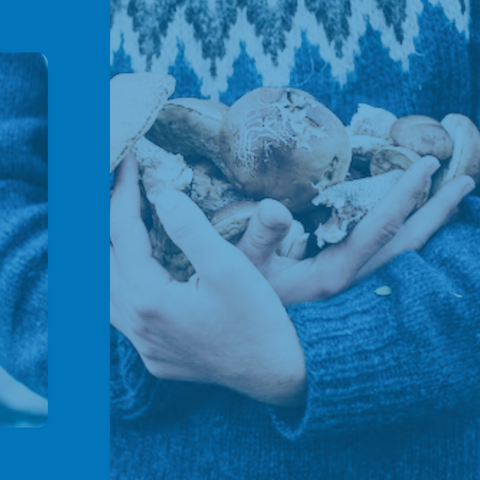
Mushrooms have been consumed as part of the human diet as a food source for many centuries [1], yet “mushroom nutraceuticals” are only a recent development [2]. These products use mushroom-derived agents to promote health and wellness. Of these, the most extensively studied pharmacologically active components are polysaccharides and polysaccharide-protein complexes, triterpenes, lectins, and fungal immunomodulatory proteins [3].
Medicinal mushrooms have been credited with over 130 health benefits and therapeutic properties, including anti-cancer, antioxidant, hepatoprotective, anti-diabetic, antimicrobial, cholesterol-lowering, and genoprotective effects [1,3]. There is also evidence that they have beneficial effects on depression, kidney and bone health, and cardiovascular function [4].
The scientific community is in the process of establishing the therapeutic value and pharmacological activity of medicinal mushrooms, so-called “mycotherapy,” in robust clinical trials [4]. As of 2021, there were around 200 registered clinical trials, largely focused on cancer treatments with oral administration [5].
Now, let’s discuss some of the most common therapeutic mushrooms and how they work.
Psilocybin Mushrooms
Perhaps the most famous therapeutic mushrooms are those referred to as “magic mushrooms,” which include the psilocybe, panaeolus, inocybe, pluteus, gymnopilus, and pholiotina classes [6]. Humans have exploited the psychedelic effects of these mushrooms for thousands of years, as part of religious and spiritual ceremonies [7,8].
The effects of psilocybin mushrooms are a consequence of their psilocybin and psilocin content. After consuming these mushrooms, the liver breaks down or metabolizes psilocybin into psilocin, which is the key component in promoting psychedelic effects [9]. In fact, it is this component that shows promise in the treatment of depression and other mental disorders. It is thought that these effects are brought about by the stimulation of serotonin receptors [10].
Psychedelic use of these mushrooms was extensively associated with the counterculture movement of the 1960s, and received considerable negative stigmatization. In 1970, the United States government deemed these mushrooms as Schedule 1 drugs [11], which ultimately ended scientific research on them.
However, there has been renewed interest in psychedelic mushrooms since 2004 due to a pilot study from the University of California in Los Angeles that explored the potential of psilocybin treatment in patients with advanced stage cancer [7]. The potential for psilocybin to treat mood disorders, anxiety, and drug dependence has also been investigated in the early 21st century [12].
If you’re interested in learning more about psychedelics, check out this podcast episode with Dr. Dave Rabin, or if you’d like to read about psychedelics as nootropics, check out this article.
Almond Mushrooms
Agaricus subrufescens or almond mushrooms are used in traditional and alternative medicine for their potential anti-cancer effects, however their safety has not yet been robustly established [13]. In a study using a cancer cell line, extracts from almond mushrooms brought about autophagy or cell death [14].
Lacquered Bracket
Ganoderma lucidum or lacquered bracket has been used as a functional food and preventative medicine in the Far East for at least two millennia. It has important bioactive properties, including anti-tumor activity caused by bringing about autophagy [15,16].
Witch’s Butter
Tremella mesenterica or witch’s butter is found in forested areas and is widely distributed in temperate and tropical regions. It grows on dead and decaying trees and is yellow in color. It produces polysaccharides that have immunostimulatory, anti-diabetic, anti-inflammatory, and hepatoprotective properties [17]. A study involving cell models has also shown anti-cancer effects with a focus on the lungs [18].
Cordyceps
Cordyceps (derived from the Latin words cord and ceps meaning club and head, respectively) has a history of medicinal use across the past millennia in Asia [19], and has a growing presence in traditional Chinese fungal medicine [20]. It is a rare mushroom that can be found at high altitudes on the Himalayan plateau [21].
Analytical results of the composition of cordyceps grown in culture media reveal a number of bioactive components, such as cordycepin, polysaccharides, GABA, ergothioneine, and many more [19].
Cordycepin is regarded as the most prominent bioactive component due to its therapeutic and nutraceutical potential [21]. Research has shown its promise in fighting inflammation, enhancing immunity, and suppressing cytokine storms (such as those seen during the COVID-19 pandemic) [22]. These anti-inflammatory effects may be brought about via the TGF-beta 1/Smad signaling pathway.
Rodent studies have shown that cordycepin can increase the level of osteocalcin, a marker of bone formation, and decrease levels of CTX, a marker of bone resorption, while restoring oxidative stress levels [23].
Summary
We have taken a closer look at several different types of mushrooms that have wide-ranging health effects with implications for human health and disease. While it is clear that many medicinal mushrooms have anti-tumor or anti-cancer effects, these need to be examined in further robust clinical trials. There is also good evidence from cell models that certain mushrooms have potent anti-inflammatory activity and can promote immunity alongside cardiovascular, neurological, and bone health. Others, particularly psilocybin mushrooms, have the potential to address depression, mood disorders, and other psychological health challenges.
There are many more therapeutic mushrooms out there, of course. Which ones are your favorite? Let us know in the comments! Or tag us on Instagram and let us know!
References
[1] S.K. Panda, W. Luyten, Medicinal mushrooms: Clinical perspective and challenges, Drug Discov Today. 27 (2022) 636–651. https://doi.org/10.1016/j.drudis.2021.11.017.
[2] V.K. Chaturvedi, S. Agarwal, K.K. Gupta, P.W. Ramteke, M.P. Singh, Medicinal mushroom: boon for therapeutic applications, 3 Biotech. 8 (2018) 334. https://doi.org/10.1007/s13205-018-1358-0.
[3] S. Chang, J. Buswell, Medicinal Mushrooms: Past, Present and Future, Adv Biochem Eng Biotechnol. (2022). https://doi.org/10.1007/10_2021_197.
[4] G. Venturella, V. Ferraro, F. Cirlincione, M.L. Gargano, Medicinal Mushrooms: Bioactive Compounds, Use, and Clinical Trials, Int J Mol Sci. 22 (2021) 634. https://doi.org/10.3390/ijms22020634.
[5] E.J. Murphy, E. Rezoagli, I. Major, N.J. Rowan, J.G. Laffey, β-Glucan Metabolic and Immunomodulatory Properties and Potential for Clinical Application, J Fungi (Basel). 6 (2020) 356. https://doi.org/10.3390/jof6040356.
[6] K. Gotvaldová, J. Borovička, K. Hájková, P. Cihlářová, A. Rockefeller, M. Kuchař, Extensive Collection of Psychotropic Mushrooms with Determination of Their Tryptamine Alkaloids, Int J Mol Sci. 23 (2022) 14068. https://doi.org/10.3390/ijms232214068.
[7] H. Lowe, N. Toyang, B. Steele, H. Valentine, J. Grant, A. Ali, W. Ngwa, L. Gordon, The Therapeutic Potential of Psilocybin, Molecules. 26 (2021) 2948. https://doi.org/10.3390/molecules26102948.
[8] R.R. Griffiths, M.W. Johnson, W.A. Richards, B.D. Richards, U. McCann, R. Jesse, Psilocybin occasioned mystical-type experiences: immediate and persisting dose-related effects, Psychopharmacology (Berl). 218 (2011) 649–665. https://doi.org/10.1007/s00213-011-2358-5.
[9] T. Passie, J. Seifert, U. Schneider, H.M. Emrich, The pharmacology of psilocybin, Addict Biol. 7 (2002) 357–364. https://doi.org/10.1080/1355621021000005937.
[10] M.K. Madsen, P.M. Fisher, D. Burmester, A. Dyssegaard, D.S. Stenbæk, S. Kristiansen, S.S. Johansen, S. Lehel, K. Linnet, C. Svarer, D. Erritzoe, B. Ozenne, G.M. Knudsen, Psychedelic effects of psilocybin correlate with serotonin 2A receptor occupancy and plasma psilocin levels, Neuropsychopharmacology. 44 (2019) 1328–1334. https://doi.org/10.1038/s41386-019-0324-9.
[11] K. Wang, Y. Sun, B. Nava, L. Sampiere, R.J. Jacobs, Predictors of Medical Students’ Perceptions of Psilocybin-Assisted Therapy for Use in Medical Practice, Cureus. 15 (2023) e37450. https://doi.org/10.7759/cureus.37450.
[12] R.E. Doblin, M. Christiansen, L. Jerome, B. Burge, The Past and Future of Psychedelic Science: An Introduction to This Issue, J Psychoactive Drugs. 51 (2019) 93–97. https://doi.org/10.1080/02791072.2019.1606472.
[13] K. Wisitrassameewong, S.C. Karunarathna, N. Thongklang, R. Zhao, P. Callac, S. Moukha, C. Férandon, E. Chukeatirote, K.D. Hyde, Agaricus subrufescens: A review, Saudi J Biol Sci. 19 (2012) 131–146. https://doi.org/10.1016/j.sjbs.2012.01.003.
[14] M.-J. Fan, Y.-C. Lin, H.-D. Shih, J.-S. Yang, K.-C. Liu, S.-T. Yang, C.-Y. Lin, R.S.-C. Wu, C.-S. Yu, Y.-C. Ko, J.-G. Chung, Crude extracts of Agaricus brasiliensis induce apoptosis in human oral cancer CAL 27 cells through a mitochondria-dependent pathway, In Vivo. 25 (2011) 355–366.
[15] F. Reis, R. Lima, P. Morales, I. Ferreira, M. Vasconcelos, Methanolic Extract of Ganoderma lucidum Induces Autophagy of AGS Human Gastric Tumor Cells, Molecules. 20 (2015) 17872–17882. https://doi.org/10.3390/molecules201017872.
[16] E. Calviño, J.L. Manjón, P. Sancho, M.C. Tejedor, A. Herráez, J.C. Diez, Ganoderma lucidum induced apoptosis in NB4 human leukemia cells: involvement of Akt and Erk, J Ethnopharmacol. 128 (2010) 71–78. https://doi.org/10.1016/j.jep.2009.12.027.
[17] E. Vinogradov, B.O. Petersen, J.O. Duus, S.P. Wasser, The Isolation, Structure, and Applications of the Exocellular Heteropolysaccharide Glucuronoxylomannan Produced by Yellow Brain Mushroom Tremella mesenterica Ritz.:Fr. (Heterobasidiomycetes), Int J Med Mushr. 6 (2004) 335–346. https://doi.org/10.1615/IntJMedMushr.v6.i4.40.
[18] N.-Y. Chen, H.-H. Lai, T.-H. Hsu, F.-Y. Lin, J.-Z. Chen, H.-C. Lo, Induction of apoptosis in human lung carcinoma A549 epithelial cells with an ethanol extract of Tremella mesenterica, Biosci Biotechnol Biochem. 72 (2008) 1283–1289. https://doi.org/10.1271/bbb.70773.
[19] K.J. Jędrejko, J. Lazur, B. Muszyńska, Cordyceps militaris: An Overview of Its Chemical Constituents in Relation to Biological Activity, Foods. 10 (2021) 2634. https://doi.org/10.3390/foods10112634.
[20] H.S. Tuli, S.S. Sandhu, A.K. Sharma, Pharmacological and therapeutic potential of Cordyceps with special reference to Cordycepin, 3 Biotech. 4 (2014) 1–12. https://doi.org/10.1007/s13205-013-0121-9.
[21] S.A. Ashraf, A.E.O. Elkhalifa, A.J. Siddiqui, M. Patel, A.M. Awadelkareem, M. Snoussi, M.S. Ashraf, M. Adnan, S. Hadi, Cordycepin for Health and Wellbeing: A Potent Bioactive Metabolite of an Entomopathogenic Cordyceps Medicinal Fungus and Its Nutraceutical and Therapeutic Potential, Molecules. 25 (2020) 2735. https://doi.org/10.3390/molecules25122735.
[22] L. Tan, X. Song, Y. Ren, M. Wang, C. Guo, D. Guo, Y. Gu, Y. Li, Z. Cao, Y. Deng, Anti‐inflammatory effects of cordycepin: A review, Phytotherapy Research. 35 (2021) 1284–1297. https://doi.org/10.1002/ptr.6890.
[23] D. Zhang, H. Deng, W. Qi, G. Zhao, X. Cao, Osteoprotective effect of cordycepin on estrogen deficiency-induced osteoporosis in vitro and in vivo, Biomed Res Int. 2015 (2015) 423869. https://doi.org/10.1155/2015/423869.





Comments (0)
There are no comments for this article. Be the first one to leave a message!